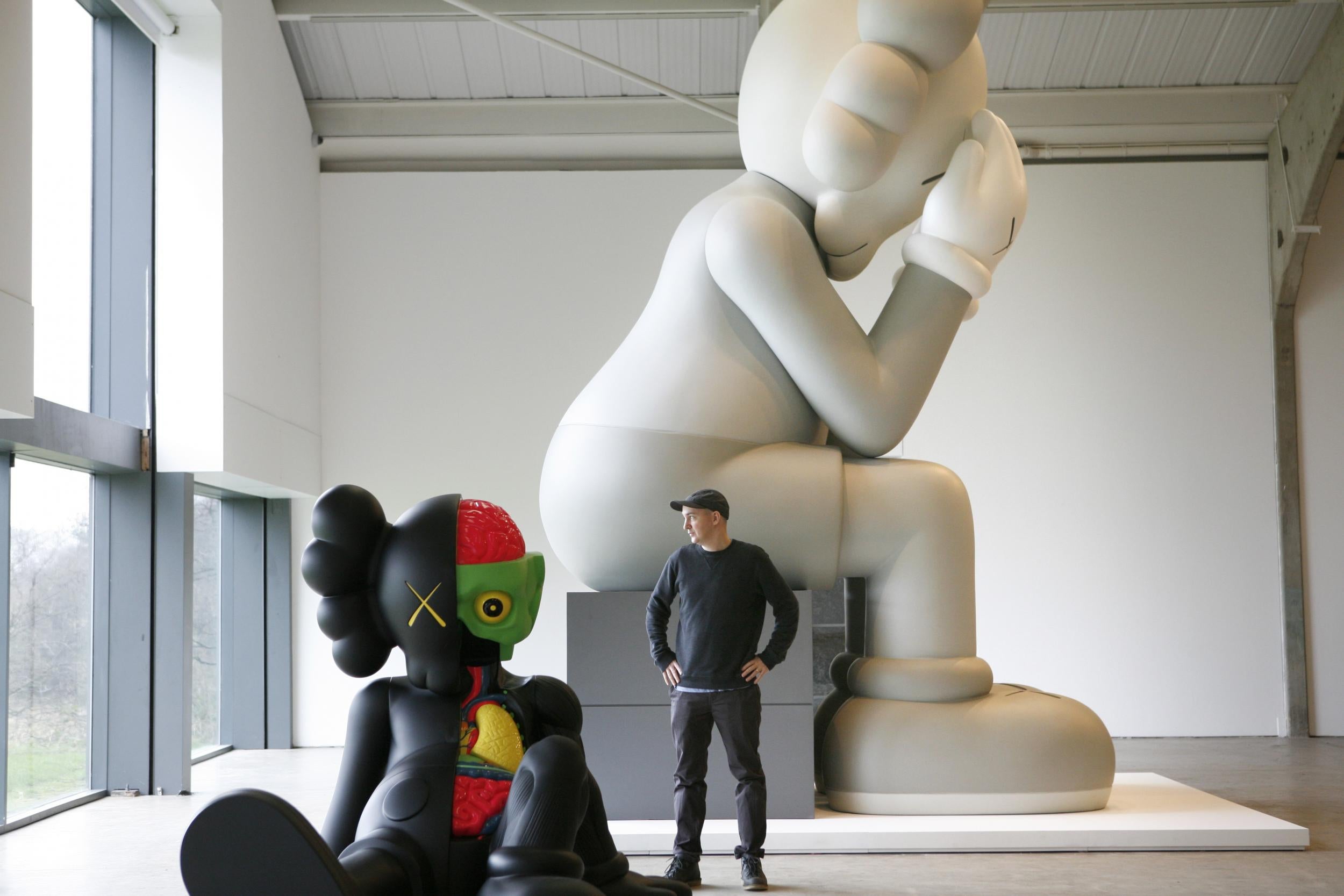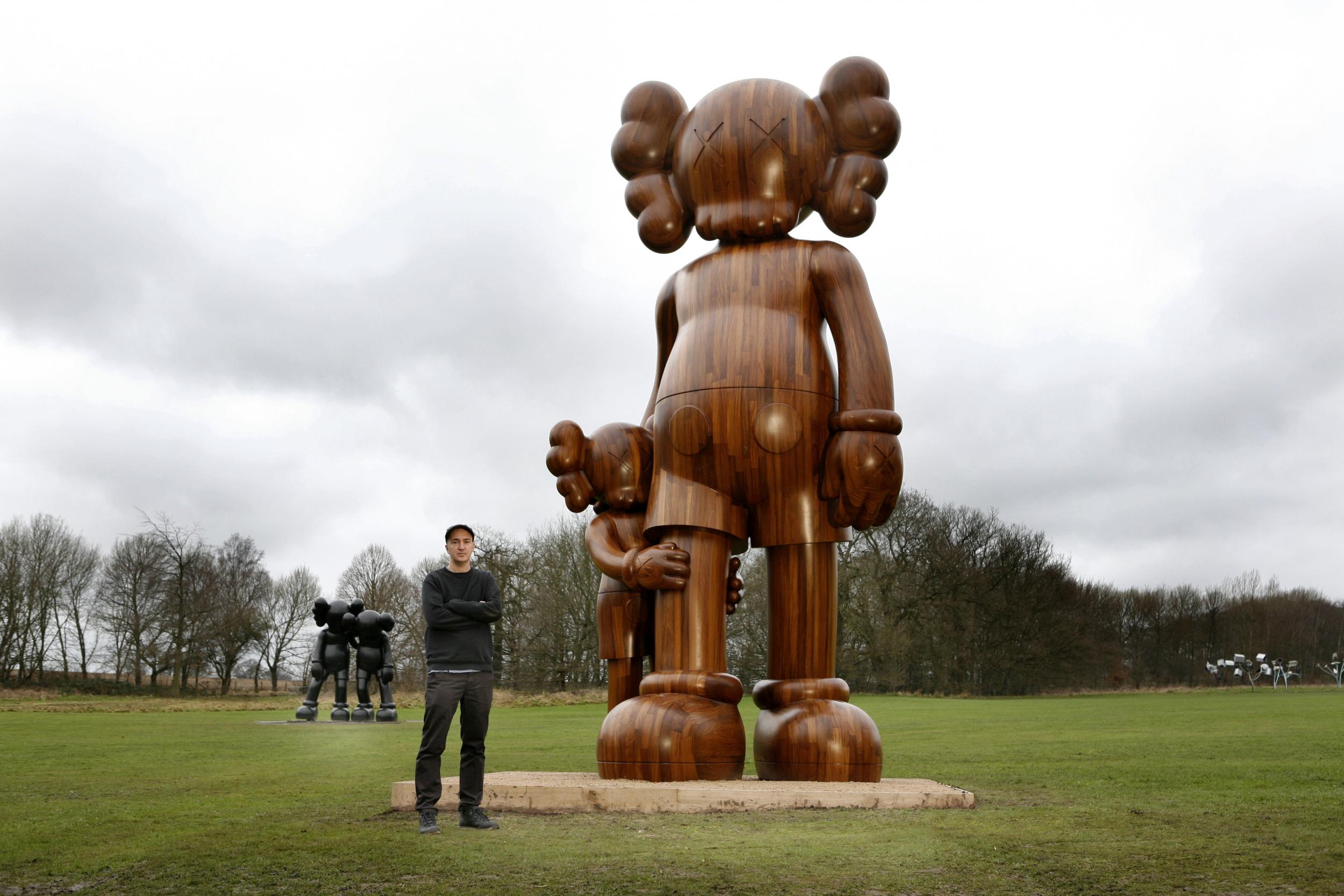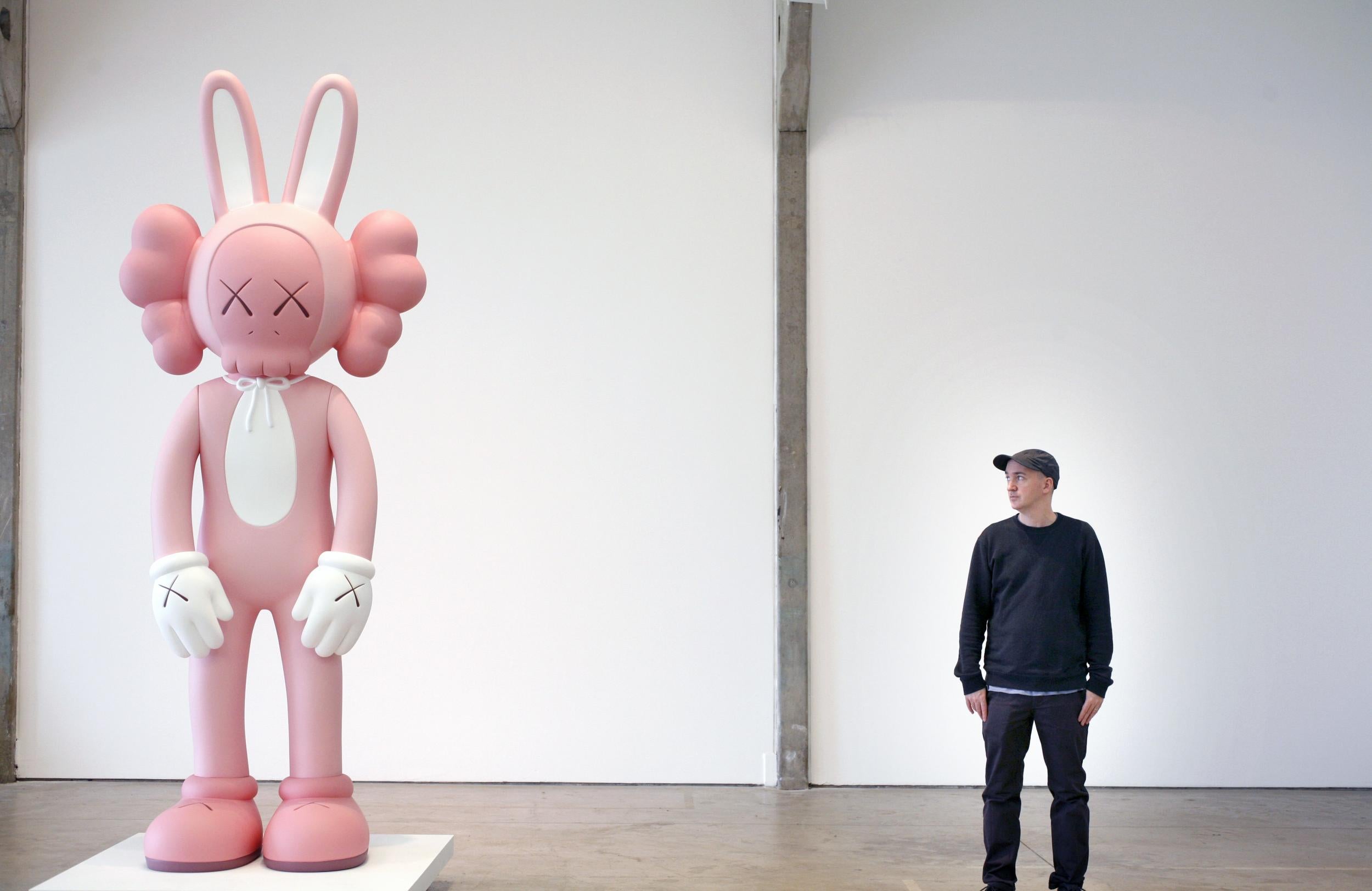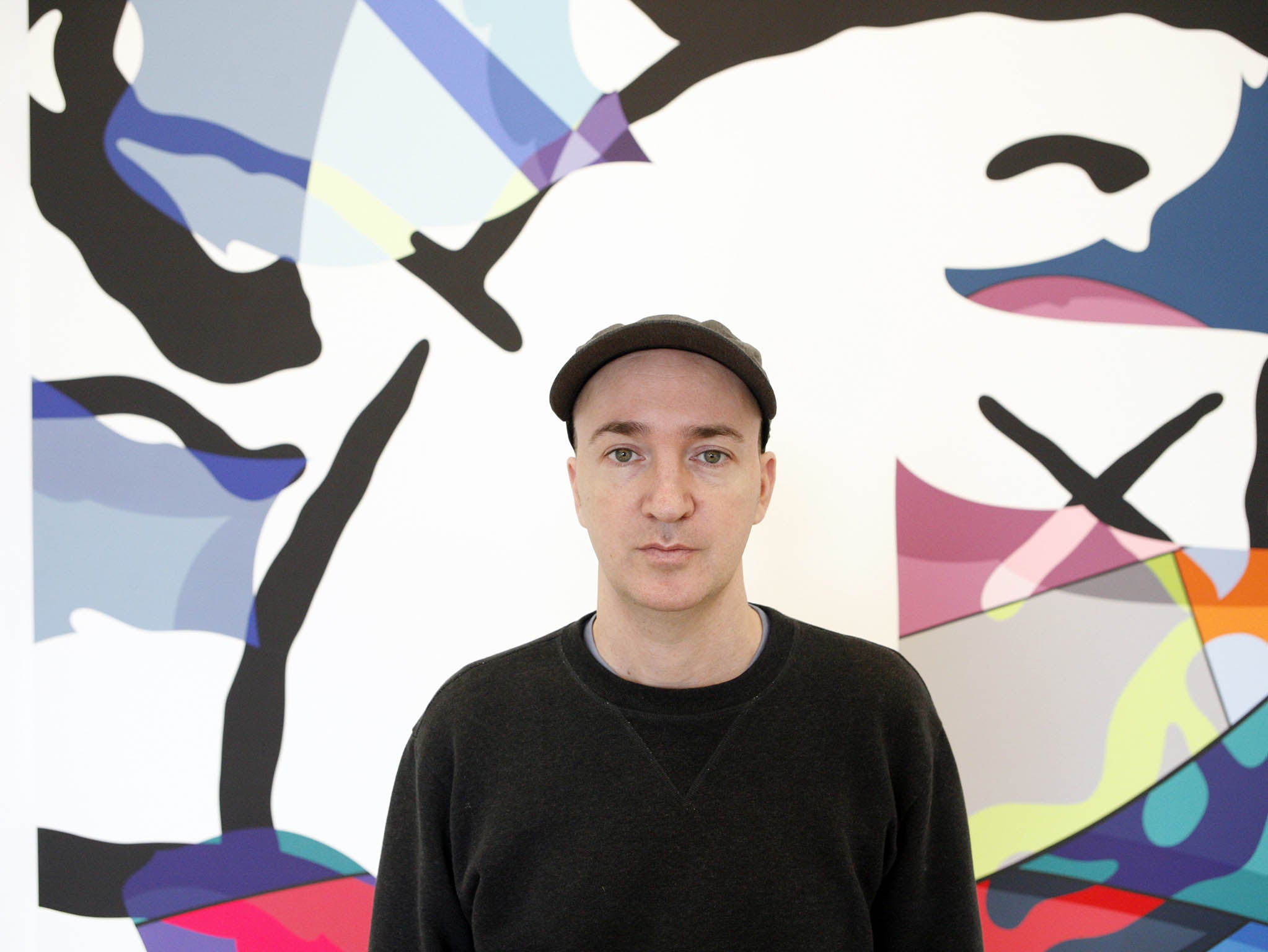Pop artist KAWS' gigantic cartoon sculptures will be taking over the Yorkshire countryside
The New Yorker, aka Brian Donnelly, is an artist, toymaker and brand - and he's now readying his first major UK show. Hettie Judah meets him

The rain is crisping towards hail as it lashes a squat building in the West Yorkshire countryside. Inside, Brian Donnelly, known to a community of fans around the world by the alias KAWS, is installing a family of recent sculptures.
The head of each figure bears traces of a skull and crossbones – blobby bones take the place of ears and a frill of teeth stands in for the mouth, while their dead-men’s eyes are X-marks-the-spot crosses. It’s a cartoon pirate signature that makes them instantly recognisable as the work of KAWS.
The group in the gallery are diminutive siblings to a quintet of gargantuan figures installed on the other side of the valley in the Yorkshire Sculpture Park’s lakeside gardens. “I love it,” enthuses Donnelly. “I love the photos you can get from it and the rolling hills and these giant wooden pieces among all the trees.”
As a pioneer of art-as-brand, with an eye-catching practice that draws heavily on urban artforms and a synthetic aesthetic, this is an incongruous setting for the New York-based artist’s first major UK show.
A week ahead of the opening, the installation team is laying fresh turf around the plinths, and stabilising paths churned up into gritty mud by the cranes and trucks used to piece together the weighty hardwood sculptures, the largest of which – Small Lie (2013) – stands at 10 metres tall.
The characters in this exhibition have been part of the KAWS lexicon since his days as a graffiti provocateur in the 1990s, when he gained recognition modifying ads on the sides of phone booths in New York. Companion, Accomplice, Chum and Bendy – riffs on Mickey Mouse, Bugs Bunny, the Michelin Man and a giant spermatozoa – have been conveyed in spray paint, oil on canvas, T-shirt graphics and collectible toy form, eventually expanding, in the past decade, to become super-sized works of sculpture.

Their relationship to Donnelly hovers somewhere between avatar, id, conscience and inner child. The largest figure in the gallery is a five-metre-high Companion sitting with his head in his hands, originally commissioned for a ferry port in Hong Kong, and suggestive of the artist’s own tendency to feel isolated in a numb crowd.
“I went on a site visit to Kowloon and there was just a sea of people,” recalls Donnelly. “It’s easy to pass people sitting on the street like this all day long – you don’t think twice – but when you see something on that scale you might stop and think a little more about what’s going on.”
A neighbouring Companion – this partially dissected to reveal neon inner organs – is shown reclining. Its pose might recall, at a push, Antonio Canova’s sleeping Endymion, but for Donnelly the composition sprang from simple empathy: “I was just thinking about giving the figure a break. This toy’s sat on my shelf for some years and I pictured him relaxing.”
Donnelly was shod in fresh white Vans when he visited the Yorkshire Sculpture Park last summer, but he’s not making that mistake again. Today he’s wearing heavy-soled walking boots. Their label is not evident, but it’s fair to assume that like many things Donnelly comes into contact with, they are obscure, limited-edition and highly covetable. A slight figure, and so softly spoken that at times his voice barely registers on a recording mic, Donnelly is nonetheless a member of that informal international club that defines a certain kind of 21st-century man-into-boy cool.
Peter Pan-like figures, they dictate an object fetishism that draws on the accoutrements of teendom and young manhood: graffiti, skateboarding, figurines, cartoons, sneakers, rare bands, rare brands, and other things that broadcast in-the-know-dom.
In the late 1990s, Donnelly shifted his focus from the telephone booths of New York to the savvy young entrepreneurs of Japan with whose eye for detail, urge to collect, and cool kid nerdiness he felt kinship.

In Tokyo, he began producing collectible toy figurines, started his own brand (Original Fake), and collaborated with fashion houses, of which the most notable was BAPE, a label that was the apex of desirability for a certain tranche of hip and rarefied consumer. BAPE also had a gallery, and it was there that Donnelly first showed artworks of scale.
Thanks to Donnelly’s decision to focus his energies on “product” rather than traditional artworks, the US art system, until very recently, gave him short shrift. His Original Fake brand was so popular that he “killed it” because it was taking over his life, but eight years ago he couldn’t get gallery representation in his home country.
A waving turd character – Warm Regards – first appeared in response to a 2008 touring show in which Donnelly’s peers were invited to show recent work, while his involvement was limited to graffiti pieces from the 1990s. At the last stop on the tour, Donnelly was invited to paint a mural – Warm Regards was his expressive gesture of “thanks” for being sidelined.
BAPE’s founder, Nigo, was, as Donnelly puts it “an eccentric collector dude” who amassed fine cars, mid-century furniture and whose house featured exclusively KAWS artwork.
“Everyone who went to Tokyo – Jay Z, Pharrell, Kanye – wanted to see Nigo,” recalls Donnelly. “And they went to his house where they saw the best Bentleys and the best Prouvé vintage furniture. That was their first impression when they saw the work, and that really got it out to a lot of people.”
It was Pharrell who provided Donnelly’s entrée into the world of art fairs, auction houses and air kissing that today passes as the upper end of the contemporary art market. The French gallerist Emmanuel Perrotin was at Pharrell’s house and “Pharrell cold-called me: ‘Hey, Emmanuel’s here! Talk to him!’ It was very awkward. But that did start a ‘hello’ between us.”
Perrotin is a legendarily sporting gallerist, but such was the artworld’s suspicion of “commercial” art in the mid-Noughties that it took even him a while to come round to KAWS. Today, Donnelly is embraced by both the art and the collectibles market: “Frieze and Comic Con – what’s the difference?” he shrugs. “It’s a different crowd, a different dress, a different network, but honestly? It’s just making work and putting it into a room.” Indeed, he contrasts the obsessive, knowledgeable collecting of ephemera he encountered in Japan with the sometimes dubious machinations of the artworld: “Whether it was prototype toys or whatever, those collectors were connoisseurs of what they were looking at, they knew the history behind it, the year of the piece. People have interests, but some treat it with integrity and some don’t.”

Even rendered in materials more fitting to artworld tastes, KAWS’s figures have the impenetrable sheeny finish of a Disney figurine. The hierarchy of materials in art is something he finds hard to fathom. “I did a series called Permanent Thirty-Three (2008): bronze heads of me in different colours that I did when I was 33 years old. People approach the work in different ways – when it’s eight inches and plastic it’s a toy, if it’s eight inches in painted bronze it’s an artwork. I always felt that to be ridiculous.”
Donnelly is an ardent collector of both toys and art, and frequently communicates his passion for the work of artists such as Peter Saul and Joyce Pensato to his 400,000-odd Instagram followers. Today he sees a role for himself in providing a route into art for hordes of young fans that might otherwise, as he once did, feel that they “couldn’t go into a gallery – they’d be booked for shoplifting”.
Beyond the mud and the sleet, this personal engagement with an audience that might otherwise feel unwelcome in a museum environment is a key part of what brings KAWS to Yorkshire Sculpture Park, and what brought Yorkshire Sculpture Park to KAWS. He may be an accepted member of the artworld now, but standing in the stately parkland of their rarefied rural locale, his vast, cartoonish sculptures with their unyielding, near featureless surfaces still reek of insubordination.
KAWS, 6 Feb to 12 June, Yorkshire Sculpture Park (ysp.co.uk)
Join our commenting forum
Join thought-provoking conversations, follow other Independent readers and see their replies
Comments